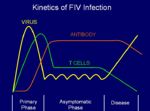Category:Secondary Immunodeficiency
- There are many causes of secondary immunodeficiency
- Most deficiencies are not genetic
- Most are agent-induced, such as from X-ray radiation and immunosuppressive drugs
Viral Causes
Feline Leukaemia Virus (FeLV)

FeLV Electron Micrograph Public Health Image Library Image #5610
- Oncogenic retrovirus
- Causes neoplasia (lymphoma), myelosuppression (anaemia) and immunosuppression (of T cells)
- 2 strains:
- FeLV-A
- Natural strain
- FeLV-B
- Formed through FeLV-A recombining with endogenous retroviral sequences in the feline genome
- Increases the risks of lymphoma
- FeLV-C
- Formed from the spontaneous mutation of FeLV-A
- Is more myelosuppressive
- FeLV-A
- Virus replicates in the oropharyngeal lymphoid tissue causing a viraemia (virus circulating in the bloodstream) which then spreads to the systemic lymphoid tissue
- Shed in saliva
- Passed by oronasal route, e.g. mutual grooming
- Kittens between 6 weeks and 6 months are most susceptible
- 60% of cats will become immune to the disease and recover
- Cats that are persistently viraemic will progress to develop FeLV-associated diseases
- Some cats will become viraemic again if treated with corticosteroids or stressed if the infection lies dormant in the bone marrow
- Diagnosis:
- ELISA
- Rapid-Immuno-Migration
- Western Blot
- Virus Isolation
- Immunofluorescence
- PCR
- Treatment:
- Antibiotics for secondary infection
- Anti-retroviral therapy
- For vaccinations see here
Feline Immunodeficiency Virus (FIV)
- Lentivirus
- Subtypes A, B and D
- Causes increased susceptibility to infections and neoplasia
- Specifically destroys CD4+ T cells
- Virus is present in saliva, blood and other bodily fluids
- Feral and outdoor cats (mostly tom cats) are most at risk
- Virus replicates in lymphoid tissue
- Can remain asymptomatic
- Causes pyrexia and lymphadenopathy
- Transmitted by biting
- Diagnosis:
- ELISA
- Rapid-Immuno-Migration
- Western Blot
- Virus Isolation
- Immunofluorescence
- PCR
- Treatment:
- Antibiotics for secondary infection
- Anti-retroviral therapy
- For vaccinations see here
Bovine Immunodeficiency Virus (BIV)
- Lentivirus (non-oncogenic)
- Causes a persistent viral infection and lymphocytosis
- Immunocompromised cattle may develop secondary infections
- The transmission is not well known, but the following possibilities are being researched:
- Through milk
- Through infected semen (e.g.artificial insemination)
- Placental transfer
- Diagnosis:
- Western Blot
- PCR
Toxic Causes
- Poisons
Iatrogenic Causes
- Drugs
- Corticosteroids
- Cyclosporin
- Cytotoxic cancer therapy
Other Causes
- Malnutrition
- Chronic disease
- Stress
- Senescence
Pages in category "Secondary Immunodeficiency"
The following 3 pages are in this category, out of 3 total.
